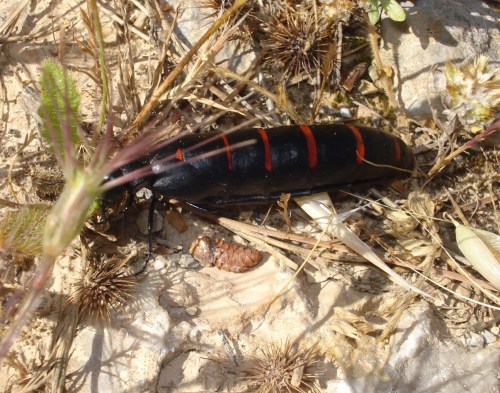Red-striped Oil Beetle – Berberomeloe majalis or Meloe majalis SPANISH: Curilla or Aceitera
Family Carabidae (Ground Beetles)
Distribution: Most of Iberia, Southern France and the coastal regions of North Africa.
Very striking and noticeable, Red-striped Oil Beetles, or Blister Beetles as they are also known, are large beetles that can reach a length of around 6 cm. The basic ground colour is black and each body segment has a red or orange stripe crossing it. The legs are positioned towards the front of the beetle’s body, leaving the rest of its bulk unsupported, which means the cylindrical abdomen has to be dragged across the ground. Although there are tiny elytra on the thorax, the beetles are unable to fly.
The presence of the beetles tends to be localized, but if the habitat and conditions are favourable, numbers of them may be seen gathered together. They favour areas with sandy soil in areas of scrub or light woodland or orchards. The presence of flowers to attract bees is vital as solitary bees play a crucial role in the development of the beetle’s larvae.

19/6/10-Sierra de las Nieves- 2 beetles, nose to tail – a male will follow a female persistently until she accepts him as a mate.
The female is much larger than the male with the shape and colouration being the same. A male will follow a female persistently until he is accepted as a mate. After mating the female lays thousands of eggs in the ground, selecting sites that are in the vicinity of solitary bees. Once hatched, the elongated larvae climb up to reach a flower and await the arrival of a bee, that must be a solitary bee. With their strong claws they attach themselves to the bee’s back in order to be carried back to the bee’s nest. Once inside the nest the beetle larva consumes one of the host’s eggs and takes up residence in the cell in its place. They continue to grow by feeding on the food mass stored for the bee pupa.
Many eggs are laid by the female Oil Beetle, but few will reach maturity due to the complexity of the chain of events necessary for a larva to secure a place in a bee’s nest where it can grow and complete its transformation. When fully matured they leave the bee’s nest, and in adult form are herbivores, feeding on different plant leaves and flowers.
HOW THE BEETLE GOT ITS NAME
The Beetle carries the classic warning colours of black and red with good reason; it is not a creature to be messed with! If an adult beetle feels threatened, a defence mechanism is to secrete an oily substance that is toxic, hence the common English name of ‘Oil Beetle’. The alternative name ‘Blister Beetle’ derives from the effect the liquid can have on a person’s skin; contact may cause skin to blister and will be extremely painful if it makes contact with your eyes.












hi have one here now on the patio. Thanks for telling me it¡s toxic. Just in case I was stupid enough to pick it up!!
LikeLike
Lucky you, they’re fascinating aren’t they? You can see why they’d have to protect themselves with nasty substances though – an insect that size would keep a hungry bird or lizard going for quite a while otherwise!
LikeLike